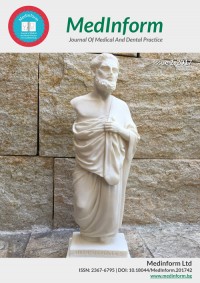Issue Two 2017
2017, Vol. 4, issue 2, (October)
Original Article
Medication-related osteonecrosis of the jaws – a retrospective study
Abstract:
Introduction: Bisphosphonates are used efficiently to treat osteoporosis, bone metastasis of malignant tumors, Paget’s disease and multiple myeloma. Bisphosphonate-related osteonecrosis of the jaws (BRONJ) represent a severe side effect, consisting of progressive bone destruction in the maxillofacial region. The aim of this study is to represent clinical information from patients diagnosed with medication-related osteonecrosis of the jaws.
Materials and Methods: A retrospective study was performed over 32 patients hospitalized in the Specialized Hospital for Maxillofacial surgery in Sofia, Bulgaria. All of them diagnosed with osteonecrosis of the jaws. The selection criteria of the patients were based on the existence of previous history for bisphosphonate treatment.
Results: Thirty-one patients were on a bisphosphonate therapy for bone metastasis. Among cancer patients was announced the use of denosumab and zoledronic acid. One patient has received oral treatment with ibandronic acid for osteoporosis. In 23 patients, bone lesions involved the lower jaw, while in 9 patients the lesions persisted in the maxillary bone. Twenty-eight patients were diagnosed with second stage of BRONJ. Exposed bone, purulent secretion, fistulas and swelling were clinically observed among patients. All of the patients received antibiotic treatment for BRONJ, while 2 of them were treated surgically. All patients were signed out after an improvement, as a result from the treatment. Six patients were hospitalized again after time of remission.
Conclusion: In conclusion, the study shows that BRONJ is mainly associated with the use of denosumab and zoledronic acid. Most of the patients seek medical attention in the second stage of osteonecrosis. The recommended conservative treatment with antibiotics can lead only to remission in some cases.
Authors:
Rossen Kolarov; Department of Oral Surgery;Daniel Rachev; Faculty of Dental Medicine;
Desislav Dobrev; Faculty of Dental Medicine;
Borislava Toncheva; Faculty of Dental Medicine;

